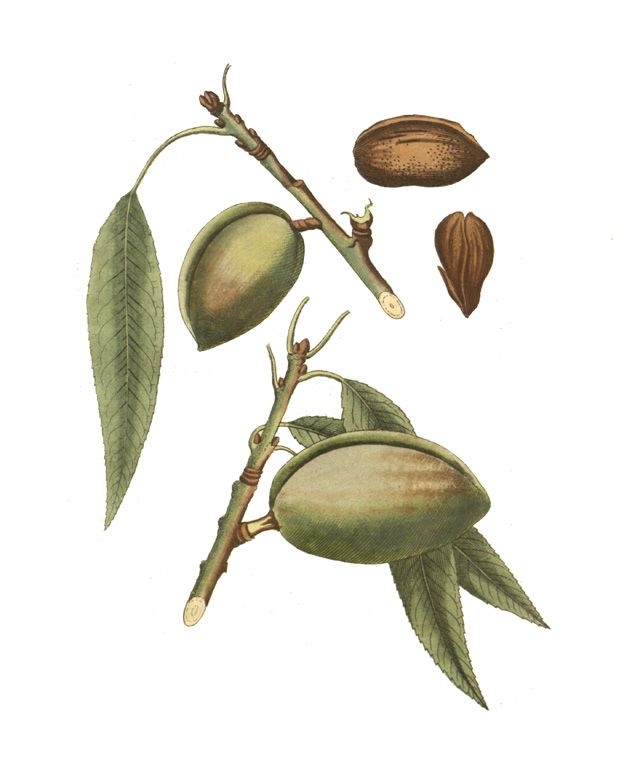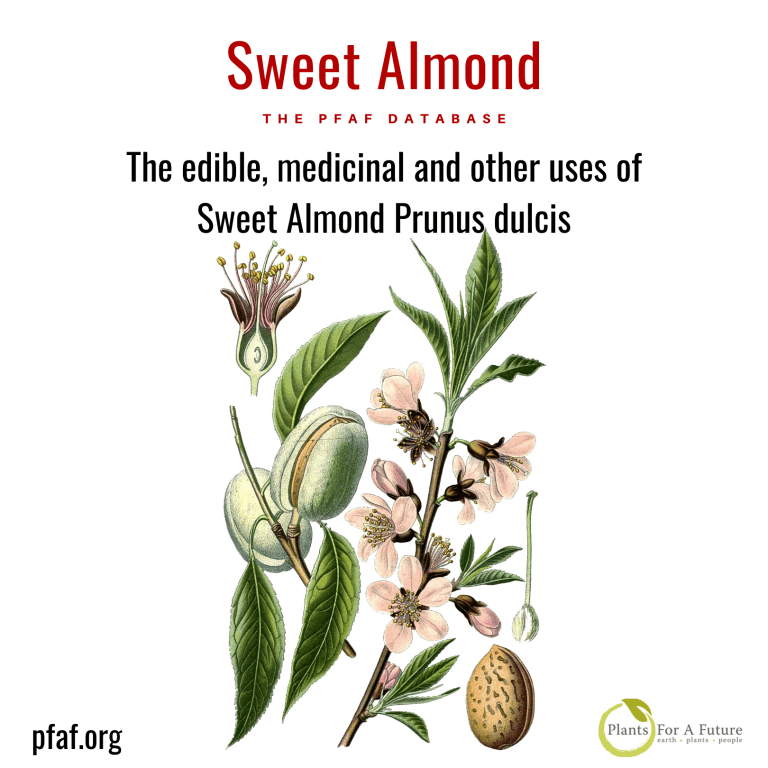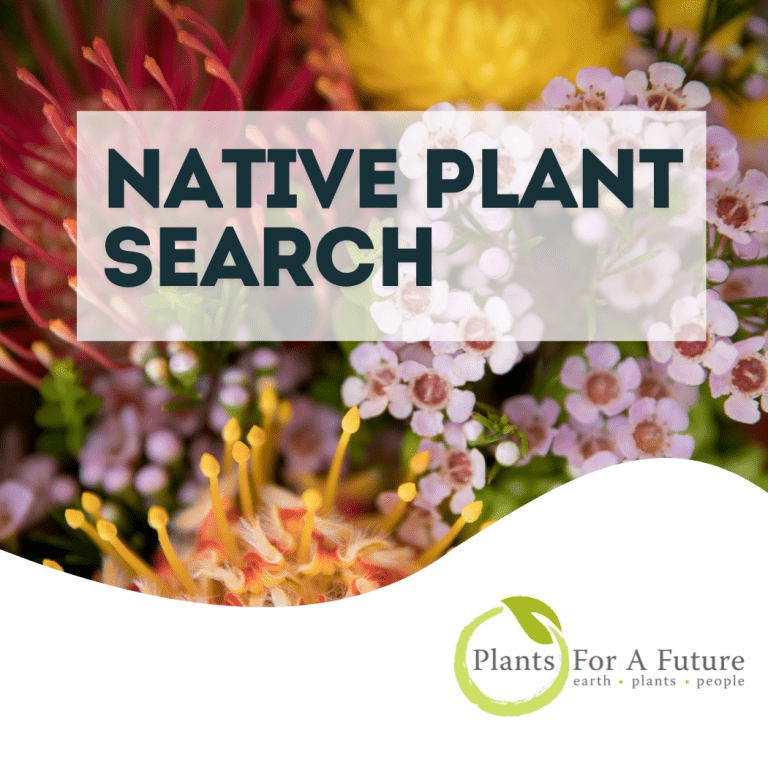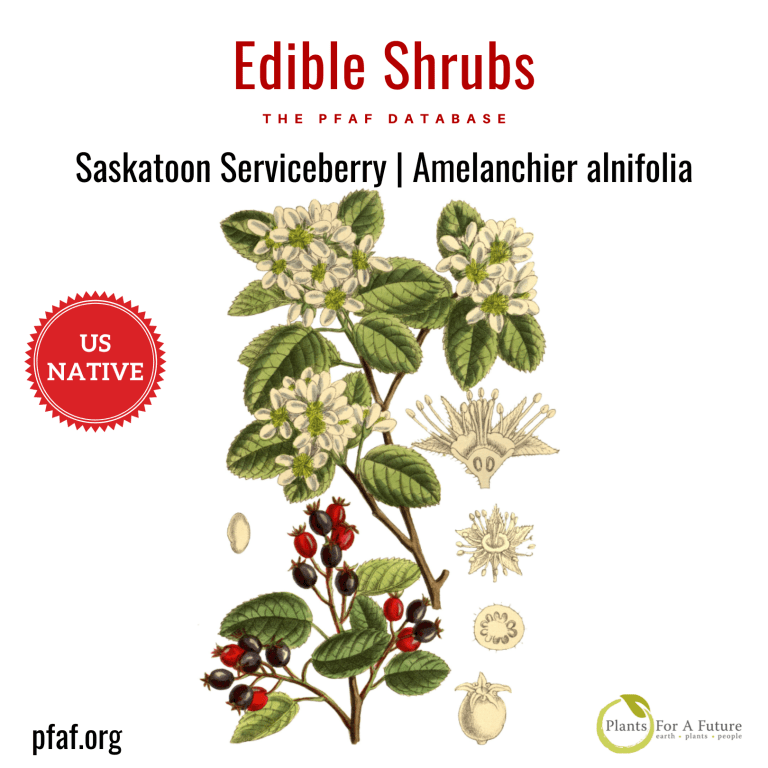Sweet almond is an attractive small deciduous tree growing to 6m (20ft) by 6m (20ft) with a short life span. Flowers are white to pale pink, 3–5cm (1–2”) in diameter, with five petals appearing in spring, and the seeds ripen in late autumn. Flowers are hermaphrodites and are pollinated by insects. Cultivars can be self-fertile, but some varieties need cross-pollination. Low humidity is preferred. Avoid exposed, windy sites or frost pockets. Can be trained as an open-centred, freestanding tree or as a fan on a sunny wall. “Almond” is also the name of the edible and widely cultivated seed of this tree. Planting habitats for almond trees include a woodland garden secondary tree on a sunny edge, dappled shade, on a sunny wall, and as a specimen plant. Commercially they are grown in orchards. Average nut yields are 5–18kg (10–40lb).
The seed/nut can be eaten raw, cooked or dried and ground into a powder for use in confections. The whole seed can also be roasted, sprouted or used in cakes, confectionery and pastry. The sweet-flavoured forms have a delicious flavour, but bitter forms should not be eaten in any quantity – see the notes below on toxicity. The seed is somewhat difficult to digest and needs to be thoroughly masticated. It can be blended with water to make almond milk. Edible oil is obtained from the seed and used mainly for food flavouring and cooking. An edible gum is obtained from points of damage on the stems. The almond contains 26% carbohydrates (12% dietary fibre, 6.3% sugars, 0.7% starch) and can be made into flour for cakes and biscuits for low-carbohydrate diets. A standard serving of almond flour, 1 cup, contains 20 grams of carbohydrates, of which 10g is dietary fibre, for a net of 10g of carbohydrate per cup.

As well as being a tasty addition to the diet, almonds are beneficial to the overall health of the body, being used mainly in the treatment of kidney stones, gallstones and constipation. The oil is applied to dry skins and is often used as a carrier oil in aromatherapy. The seed is demulcent, emollient, laxative, nutritive and pectoral. When used medicinally, the fixed oil from the seed is usually employed. The seed contains ‘laetrile’, a substance that has also been called vitamin B17. This has been claimed to have a positive effect in cancer treatment, but there does not seem to be much evidence to support this. The pure substance is almost harmless, but it yields hydrocyanic acid, a very rapidly acting poison on hydrolysis – it should thus be treated with caution. This exceedingly poisonous compound stimulates respiration in small amounts, improves digestion, and gives a sense of well-being. The leaves are used in the treatment of diabetes. The plant contains the antitumour compound taxifolin. There is insufficient scientific evidence to rate the effectiveness of Prunus dulcis for cancer of the bladder, breast, mouth, spleen, and uterus, chapped and irritated skin, constipation, and several other conditions – more research is needed.
Almond trees have several other uses, including adhesives, a cleanser, cosmetics, dye, gum, oil, and soap making. An oil expressed from the seeds is an excellent lubricant in delicate mechanisms such as watches. It is often used in soaps and cosmetics because it has a softening effect on the skin. A green dye can be obtained from the leaves. A dark grey to green dye can be obtained from the fruit. A yellow dye is obtained from the roots and leaves. When rubbed within any container, the bruised leaves will remove strong odours such as garlic or cloves so long as any grease has first been fully cleaned off. A gum from the stems is used as an adhesive. The burnt shell yields a valuable absorbent for coal gas. The burnt pericarp is rich in potassium; it is used in soap making. The seed contains amygdalin; under the influence of water and in the presence of emulsion, it can be hydrolyzed to produce benzaldehyde (the almond aroma, formula C6 H5 CHO) and prussic acid (the toxic principle).
Sweet almond thrives in a well-drained moisture-retentive loamy soil, preferring some lime in the soil but is likely to become chlorotic if too much is present. It succeeds in sun or partial shade though it fruits better in a sunny position. Nut quality improves if harvested in dry weather. There are many named varieties. Almonds prefer a Mediterranean climate with a clear distinction between winter and spring; in milder maritime areas, they can be induced into flower too early in the season and are then very liable to be damaged by frosts. There is also likely to be a shortage of pollinating insects when the tree is in flower so hand pollination may improve the crop. Although partially self-fertile, better yields are obtained if at least two cultivars are grown. There are two primary forms of almonds, one with bitter seeds and one with ‘sweet’ seeds. The presence of hydrogen cyanide causes bitterness (see notes below). Although the bitter forms are used in making marzipan and as a food flavouring, the seeds themselves should not be eaten. Even the sweet forms should not be consumed in very large quantities.
Trees are hardier when grown on a plum rootstock. Almond seedlings are the preferred rootstock when plants are grown on hot, dry soils. Peach rootstocks are better for heavier soils. Trees are at least partially self-sterile. Most members of this genus are shallow-rooted and will produce suckers if the roots are damaged. Self-fertile cultivars not requiring cross-pollination are available e.g. ‘All-in-One’, setting a small nut crop. Plants in this genus are notably susceptible to honey fungus. Cultivars for heavy crop production include ‘Nonpareil’, with ‘Carmel’, ‘Fritz’, Ne Plus Ultra’, ‘Price’. Frost damage to flowers or young fruit can lead to fruit set failure. Almonds begin bearing an economic crop in the third year after planting. Trees reach full bearing five to six years after planting. The fruit matures in the autumn, 7–8 months after flowering.
Seed requires 2–3 months of cold stratification and is best sown in a cold frame as soon as it is ripe. Sow stored seed in a cold frame as early in the year as possible. Protect the seed from mice etc. The seed can be relatively slow, sometimes taking 18 months to germinate. Prick out the seedlings into individual pots when they are large enough to handle. Grow them on in a greenhouse or cold frame for their first winter and plant them out in late spring or early summer of the following year. Cuttings of half-ripe wood with a heel are taken in high summer and put in a frame. Softwood cuttings from strongly growing plants can be taken in spring to early summer in a frame. Cuttings of mature wood, late autumn in a frame. Layering is recommended in spring.
In the database Prunus dulcis







